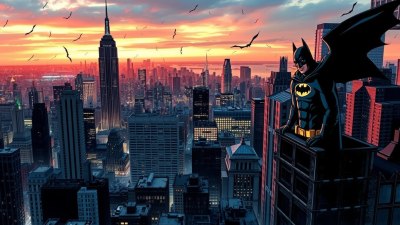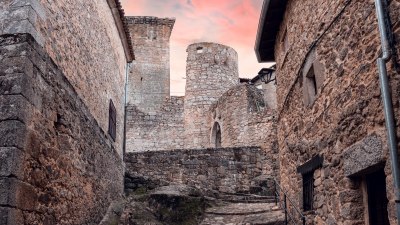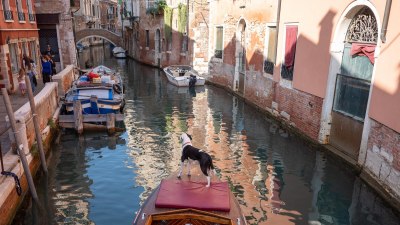The City That Inspired Gotham Before the Bat
Explore the real inspirations behind Gotham City, its history, and how it shaped Batman's universe in graphic novels.

Image created with Flux Schnell
Gotham City, one of the most iconic fictional locales in comic book history, serves as the dark and gritty backdrop for numerous tales of the Caped Crusader, Batman. However, Gotham is not just a product of imagination; it draws heavily from real-world cities, particularly New York City. This article explores the various aspects of the city that inspired Gotham before the Bat, delving into its history, culture, and architecture.
New York City has long been an influential force in literature and the arts, serving as a setting for countless narratives and stories. When Bob Kane and Bill Finger created Batman in 1939, they pulled heavily from the urban landscape of New York City, which provided an authentic backdrop to explore themes of crime, justice, and morality. With its towering skyscrapers, dark alleyways, and a bustling population, New York's façade mirrored Gotham's perilous streets.
The Architectural Blueprint
The architecture of Gotham City is perhaps its most visually striking feature, representing a blend of various styles that evoke both grandeur and decay. Buildings resembling the Gothic-inspired spires of the Woolworth Building and the Art Deco elements of the Empire State Building characterize the skyline of Gotham. These architectural elements heighten the sense of foreboding that looms over the city. Furthermore, the iconic bridges, most notably the Gotham Bridge, reflect the engineering marvels of New York while adding an air of mystery and intrigue to the cityscape.
A Tale of Two Cities
The juxtaposition of wealth and poverty in Gotham mirrors the dramatic social disparities present in New York City. Areas like Millionaire's Row contrast sharply with neighborhoods plagued by crime and corruption. This contrast serves not only to enhance the narrative surrounding Batman but also forces readers to confront issues of socio-economic disparity. Gotham's wealthy elite, represented by characters like Bruce Wayne, exemplify the privileged class, while the city's underbelly is depicted through villains and adversaries. This duality is a crucial theme that resonates throughout Batman's storylines, inviting readers to explore morality, privilege, and justice.
The Influence of Crime
The criminal world depicted in Gotham is another area where parallels to New York are drawn. The notorious history of organized crime in New York City is reflected in Gotham's criminal syndicates and mob bosses. Characters like Carmine Falcone and the Maroni family are archetypal representations of crime families that echo the tales of real-life mafia figures. The presence of gritty street gangs and villainous organizations in Gotham reflects the real dangers that plagued New York, particularly in the mid-20th century. This connection underscores the darker aspects of urban life while providing a more profound understanding of the motivations behind Batman's vigilantism.
The Role of Police and Vigilantism
The relationship between the police force and vigilantes is a crucial aspect of Gotham City, much like in New York City. The Gotham City Police Department operates under the ever-watchful eye of Commissioner Gordon, who represents the moral compass of the police amid corruption. Much like former NYPD Commissioner Bratton, who introduced innovative policing strategies to combat crime, Gordon seeks to restore order while struggling with the limitations imposed by a corrupt system. Batman, as a response to the inadequacies of the police, embodies the ideals of individual justice and vigilante authority, challenging the constraints of the justice system.
The Cultural Fabric
The cultural fabric of Gotham City is incredibly diverse, reflecting the melting pot nature of New York City. Various ethnicities, backgrounds, and stories come together to create a rich narrative tapestry. From the immigrants seeking a better life to the socially marginalized individuals, Gotham offers a microcosm of the larger societal struggles present in urban environments. Iconic characters like Lucius Fox, Barbara Gordon, and Selina Kyle add depth to the city's narrative, representing different facets of the human experience and highlighting the importance of diversity in storytelling.
Social Commentary Through Villains
The rogues' gallery of villains in Batman’s universe serves as satire and social commentary, paralleling the darker elements of urban life. Characters like the Joker, who personifies chaos and anarchy, raise questions about the nature of humanity and morality. In contrast, villains like the Riddler symbolize intellectualism corrupted by egotism and the desire for fame. This dynamic invites readers to reflect on social issues such as mental health, ethics, and the ramifications of societal neglect. As Gotham faces these antagonists, it reflects back the complexities of real-life urban challenges that often go unaddressed.
Media Representation and Evolution
The portrayal of Gotham City has evolved significantly over the decades, particularly through various media adaptations. From the campy '60s Batman series to the dark, gritty aesthetics of Christopher Nolan's film trilogy, Gotham's image adapts to fit the contemporary context of the times. Television shows like 'Gotham' and animated series provide on-screen explorations of both the city and its inhabitants, highlighting different narratives and character arcs. This evolution in representation is crucial, as it reflects societal changes and the ongoing impact of urban challenges on the public consciousness.
A City Beyond Shadows
In conclusion, the exploration of the city that inspired Gotham reveals much about the intersection of fiction and reality. Through its complex architecture, multifaceted characters, and social commentaries, Gotham City epitomizes the struggles and triumphs of urban life while serving as a canvas for tales of heroism and justice. As society continues to grapple with issues such as crime, inequality, and the quest for truth, the stories of Gotham remain as relevant today as they were when Batman first soared across its skyline. The historical and cultural touchstones of New York City will forever remain intricately woven into the fabric of Gotham, ensuring its place in both comic book lore and urban narrative.











